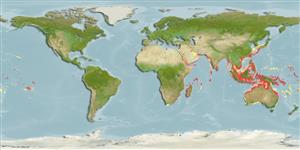Preferred temperature (Ref.
123201): 24.7 - 29, mean 28 °C (based on 1150 cells).
Phylogenetic diversity index (Ref.
82804): PD
50 = 0.5312 [Uniqueness, from 0.5 = low to 2.0 = high].
Bayesian length-weight: a=0.01349 (0.01205 - 0.01510), b=2.96 (2.93 - 2.99), in cm total length, based on LWR estimates for this species (Ref.
93245).
Nível Trófico (Ref.
69278): 3.6 ±0.54 se; based on food items.
Generation time: 1.8 ( na - na) years. Estimated as median ln(3)/K based on 2
growth studies.
Resiliência (Ref.
120179): Elevada, tempo mínimo de duplicação da população menor que 15 meses (K>0.3).
Fishing Vulnerability (Ref.
59153): Low vulnerability (18 of 100).
🛈
Climate Vulnerability (Ref.
125649): Moderate vulnerability (42 of 100).
🛈
Nutrients (Ref.
124155): Calcium = 48.5 [18.9, 86.5] mg/100g; Iron = 0.887 [0.489, 1.668] mg/100g; Protein = 20.3 [19.3, 21.4] %; Omega3 = 0.223 [0.137, 0.373] g/100g; Selenium = 16.3 [8.4, 32.1] μg/100g; VitaminA = 29.7 [9.9, 92.1] μg/100g; Zinc = 0.802 [0.534, 1.215] mg/100g (wet weight);
